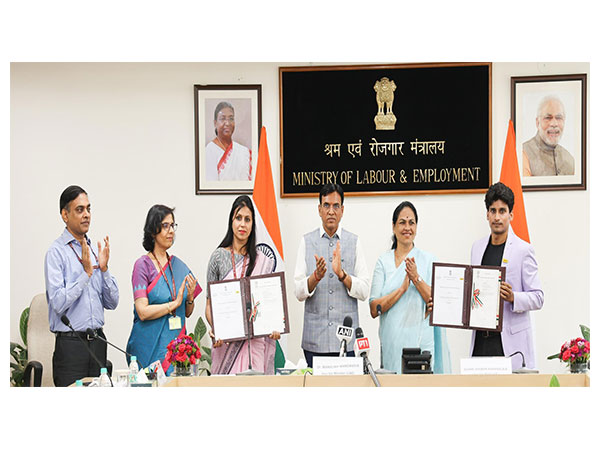Gradual shift towards the implementation of green practices
Jan 18, 2022

New Delhi [India], January 18 (ANI/NewsVoir): Agriculture continues to be a vital part of the Indian economy, accounting for about 18% of GDP. In India, agriculture still provides a living for more than half of the population.
As a result of large government initiatives and actions, sectors like seeds, fertilisers, and agrochemicals have a far-reaching impact on the Indian economy. With a market value of Rs. 40,000 crore, India's agrochemical industry is the fourth largest globally, with nearly equal shares of domestic consumption and exports.
As people become more aware of the need for environmental preservation, the agrochemical industry has responded by introducing various environment friendly crop solutions.
Weeds, diseases, and pests cost INR 45,000 crore every year, causing roughly 20% of crop output to be lost. India will need to increase agricultural production and productivity to ensure food and nutrition security as its population grows. India, with its large land and water resources supported with new initiatives in agriculture technology improvement, has the potential to become a major contributor to global needs of farm products.
Crop protection systems must be used effectively if agriculture is to be sustainable. The chemical industry has been striving to educate consumers that latest crop solution chemicals are less hazardous as they are easily degradable in the environment when coupled with judicious chemical usage and good agricultural practises (GAP).
The Indian agrochemical industry is gradually adopting more environment friendly practises. Companies have begun to implement zero discharge solutions, which has yielded considerable benefits. By implementing zero discharge solutions, agrochemical businesses can recover more than 80% of water, reduce COD levels by 40 times, and TDS levels by 60 times, allowing them to comply with government regulations, save liability costs, accomplish uninterrupted production, and lower production expenses.
The red triangle products are now being replaced by the green triangle and blue triangle products. On the other hand, water-based formulations, low-dose molecules, and target specific molecules are getting acceptance in the agrochemical sector. Companies are also concentrating on training farmers on how to use pesticides properly. Some companies have also implemented reverse logistics and are taking back the unused packaging and items.
Focus on research
Taking conscious steps towards green chemistry, the research and development activities are now focused on new active ingredients and green molecules that have minimal or absolutely no impact on the environment. That is the reason why the Indian agrochemical industry is now coming up with several green biopesticides, biofertilizers and bio stimulants.
Also, application methods of agrochemicals are mostly based on dilution of the concentrated product and then spraying the solution on the crops. According to the studies, only 5% of sprayed liquid sticks to the foliage and is absorbed by the plant whereas the remaining 95% is lost. It slips away from the plants and pollutes not only the soil but the groundwater and surface water as well. The industry should focus on technologies such as improved nozzles, electrically charged liquids, formulations with Nano particles, use of drones for spray and high performance adhesives that enhance retention further lowering the use of agrochemicals, will improve productivity, reduce costs, and will keep the environment safe.
Another major area that can majorly contribute to environmental pollution is agrochemical packaging. Most of the packaging is made of plastic and product residue normally remains in the packaging even after use. This problem can be addressed by opting for alternative packaging materials such as recycled paper or biodegradable packaging alternatives.
Emphasis is also made by the Agrochemicals Industry by advocating and working closely with the stakeholders for safer handling of pesticides while manufacturing, transporting, storing or use. Proper protection gears for the pesticides handlers are being prescribed and patronaged.
Road Ahead
The production activities of agrochemicals should be made sustainable in nature through the usage of renewable energy, net-zero approaches and effective waste management. There should be an encouragement of safe production practices and creating social and economic equity in the production workforce. Investment in the human capital through upskilling and training & development initiatives in sustainability, leadership and quality management can be focused upon by the industry players; this can help develop leaders and retain talent.
While the agrochemical industries and the Government make efforts towards making agriculture more sustainable, the farmers' acceptance and adoption of the technology, products and practices has to be at its centre.
The agrochemical industry is already connected directly with farmers through awareness creation and demand generation campaigns. The existing relations of the industry are a great strength in creating awareness related to sustainable products and practices.
The public sector extension infrastructure like Krishi Vigyan Kendras (KVKs) is being used to demonstrate beneficial farming methods. Responsible promotion of pesticides as per the label approved also an important link for mitigating any unknown environmental risks exposure.
The infrastructure and the trained human resources also present a substantial opportunity to promote sustainable agricultural practices, given the micro-level reach of the network across the country and their understanding of the local challenges and opportunities.
This story is provided by NewsVoir. ANI will not be responsible in any way for the content of this article. (ANI/NewsVoir)




















